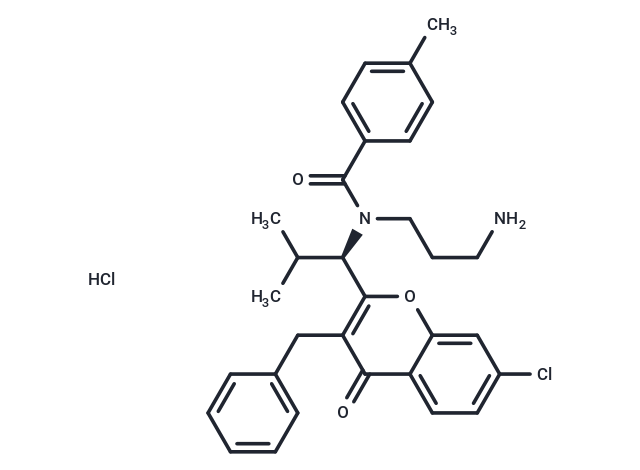Shopping Cart
- Remove All
 Your shopping cart is currently empty
Your shopping cart is currently empty

SB-743921 hydrochloride (SB743921 HCl) is an effective inhibitor of kinesin spindle protein, KSP, (Ki =0.1 nM).

| Pack Size | Price | Availability | Quantity |
|---|---|---|---|
| 1 mg | $35 | In Stock | |
| 5 mg | $108 | In Stock | |
| 10 mg | $166 | In Stock | |
| 25 mg | $292 | In Stock | |
| 50 mg | $452 | In Stock | |
| 100 mg | $692 | In Stock | |
| 500 mg | $1,580 | In Stock | |
| 1 mL x 10 mM (in DMSO) | $132 | In Stock |
| Description | SB-743921 hydrochloride (SB743921 HCl) is an effective inhibitor of kinesin spindle protein, KSP, (Ki =0.1 nM). |
| Targets&IC50 | KSP:0.1 nM(Ki) |
| In vitro | The chemical compound exhibits a notable inhibitory effect on the growth of a wide range of heterograft tumors in humans, such as Colo205, MCF-7, SK-MES-1, H69, OVCAR-3, HT-29, MX-1, MDA-MB-231, A2780, and SB-743921, effectively suppressing cellular proliferation. |
| In vivo | SB 743921 inhibits the formation of the mitotic spindle, thereby accumulating cells in mitosis and inducing cell necrosis. It is effective against human KSP (Ki=0.1 nM) and mouse KSP (Ki=0.12 nM). |
| Kinase Assay | Biochemistry assay: The motor domains of KSP (amino acids 1–360) is expressed as in Escherichia coli BL21(DE3) as COOH-terminal 6-his fusion proteins. Bacterial pellets are lysed in a microfluidizer with a lysis buffer [50 mM Tris-HCl; 50 mM KCl, 10 mM imidazole, 2 mM MgCl2, 8 mM β-mercaptoethanol, 0.1 mM ATP (pH 7.4)], and proteins are purified using Ni-NTA agarose affinity chromatography, with an elution buffer consisting of 50 mM PIPES, 10% sucrose, 300 mM imidazole, 50 mM KCl, 2 mM MgCl2, mM β-mercaptoethanol, and 0.1 mM ATP (pH 6.8). Steady-state measurements of ATPase activity are performed with a pyruvate kinase–lactate dehydrogenase detection system that coupled the appearance of ADP with oxidation of NADH. Absorbance changes are monitored at 340 nm. All biochemical experiments are performed in PEM25 buffer [25 mM Pipes/KOH (pH 6.8), 2 mM MgCl2, 1 mM EGTA] supplemented with 10 μM SB 743921 for experiments involving microtubules. Rates of ADP release are measured in a stopped-flow apparatus; the decrease in fluorescence of MANT-ATP is monitored. Rates of Pi release are measured in a stopped-flow apparatus, using bacterial phosphate binding protein modified with 7-diethylamino-3-((((2 maleimidyl)ethyl)amino)carbonyl)coumarin (MDCC) dye. Ki estimates of KSP inhibitors are extracted from the dose–response curves, with explicit correction for enzyme concentration. Tubulin polymerization by measuring changes in absorbance at 340 nm is monitored. The assay is performed in 100-μL volumes in 96-well half-area microtiter plates, using a microplate reader with the incubation temperature set at 37 °C. |
| Cell Research | All cells including HeLa cells are cultured in 10% FCS in RPMI 1640 in 5% CO2. We assessed 48-hour growth inhibition by serial dilution of SB 743921 relative to DMSO-treated cells in 96-well microtiter plates, using 3-(4,5-dimethylthiazol-2-yl)-5-(3-carboxymethoxyphenyl)-2-(4-sulfophenyl)-2H-tetrazolium. Cell growth is represented as the ratio of absorbance of treated cells to DMSO control, plotted by concentration and fitted to a four-parameter curve. Concentrations at which cellular growth is inhibited by 50% are extrapolated from the curve fit. The DNA content of HeLa cells cultured in the presence or absence of 1 μM SB 743921 for 24 hours is assessed by propidium iodide staining and flow cytometry. Immunofluorescence images are collected of HeLa cells treated for 24 hours with 1 μM SB 743921, fixed with 2% formaldehyde, permeabilized, and stained with DM1-α, anti-γ-tubulin, and 1 μg/mL 4′,6-diamidino-2-phenylindole, and with Alexa 488 secondary goat antirabbit IgG and Rhodamine-X goat antimouse IgG. Images are collected with a DeltaVision Restoration Microscopy System at a magnification of ×600. Z stacks (0.2 μm) are collected, and out of focus information is removed by constrained iterative deconvolution. Z stacks are then compressed into to a single image plane. (Only for Reference) |
| Alias | SB743921 HCl |
| Molecular Weight | 553.52 |
| Formula | C31H34Cl2N2O3 |
| Cas No. | 940929-33-9 |
| Smiles | Cl.CC(C)[C@@H](N(CCCN)C(=O)c1ccc(C)cc1)c1oc2cc(Cl)ccc2c(=O)c1Cc1ccccc1 |
| Relative Density. | no data available |
| Storage | Powder: -20°C for 3 years | In solvent: -80°C for 1 year | Shipping with blue ice. | |||||||||||||||||||||||||||||||||||
| Solubility Information | DMSO: 60 mg/mL (108.4 mM), Sonication is recommended. | |||||||||||||||||||||||||||||||||||
Solution Preparation Table | ||||||||||||||||||||||||||||||||||||
DMSO
| ||||||||||||||||||||||||||||||||||||

Copyright © 2015-2025 TargetMol Chemicals Inc. All Rights Reserved.